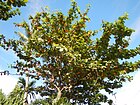Note: This is a project under development. The articles on this wiki are just being initiated and broadly incomplete. You can Help creating new pages.
Difference between revisions of "Terminalia catappa"
| (2 intermediate revisions by the same user not shown) | |||
| Line 1: | Line 1: | ||
| − | [[File: | + | [[File:A Hoverfly on a Desi Badam (Terminalia catappa) in Hyderabad, AP W IMG 0494.jpg|thumb|right|''Terminalia catappa'']] |
| − | This plant is belongs to Combretaceae family.<ref name="Plant family"/> | + | '''Indian almond''' is a fast-growing deciduous or semi-evergreen tree, usually growing about 15 metres tall with specimens up to 40 metres recorded. The canopy has a pagoda-like habit when young, but this becomes less noticeable as the tree ages and the branches elongate and droop at the tips. This plant is belongs to Combretaceae family.<ref name="Plant family"/> |
==Uses== | ==Uses== | ||
{{Uses|Stomachache}}, {{Uses|Headache}}, {{Uses|Itching}}.<ref name="Uses"/> | {{Uses|Stomachache}}, {{Uses|Headache}}, {{Uses|Itching}}.<ref name="Uses"/> | ||
==Parts Used== | ==Parts Used== | ||
| − | {{Parts Used|}}, {{Parts Used| | + | {{Parts Used|Seeds}}, {{Parts Used|Fruits}}. |
==Chemical Composition== | ==Chemical Composition== | ||
| Line 29: | Line 29: | ||
==Habit== | ==Habit== | ||
| − | {{Habit| | + | {{Habit|Semi-deciduous |
==Identification== | ==Identification== | ||
| Line 48: | Line 48: | ||
==Mode of Propagation== | ==Mode of Propagation== | ||
| − | {{Propagation|}} | + | {{Propagation|Seeds}} |
==How to plant/cultivate== | ==How to plant/cultivate== | ||
| − | <ref name="How to plant/cultivate"/> | + | Plants grow best in the lowland tropics at elevations below 800 metres.<ref name="How to plant/cultivate"/> |
==Commonly seen growing in areas== | ==Commonly seen growing in areas== | ||
| − | {{Commonly seen|}}, {{Commonly seen| | + | {{Commonly seen|Near river mouths}}, {{Commonly seen|On coastal plains}}. |
==Photo Gallery== | ==Photo Gallery== | ||
| Line 70: | Line 70: | ||
<ref name="chemical composition">[Chemistry]</ref> | <ref name="chemical composition">[Chemistry]</ref> | ||
<ref name="Leaf">[Morphology]</ref> | <ref name="Leaf">[Morphology]</ref> | ||
| − | <ref name="How to plant/cultivate">[Cultivation]</ref> | + | <ref name="How to plant/cultivate">[http://tropical.theferns.info/viewtropical.php?id=Terminalia+catappa Cultivation]</ref> |
<ref name="Uses">Indian Medicinal Plants by C.P.Khare</ref> | <ref name="Uses">Indian Medicinal Plants by C.P.Khare</ref> | ||
<ref name="Plant family">Karnataka Aushadhiya Sasyagalu By Dr.Maagadi R Gurudeva, Page no:203</ref> | <ref name="Plant family">Karnataka Aushadhiya Sasyagalu By Dr.Maagadi R Gurudeva, Page no:203</ref> | ||
| Line 76: | Line 76: | ||
==External Links== | ==External Links== | ||
| − | * [ ] | + | * [https://indiabiodiversity.org/species/show/264875 Terminalia catappa on indiabiodiversity.org] |
| − | * [ ] | + | * [http://www.flowersofindia.net/catalog/slides/Indian%20Almond.html Terminalia catappa on flowersofindia.net] |
| − | + | ||
[[Category:Herbs]] | [[Category:Herbs]] | ||
Latest revision as of 17:31, 20 August 2020
Indian almond is a fast-growing deciduous or semi-evergreen tree, usually growing about 15 metres tall with specimens up to 40 metres recorded. The canopy has a pagoda-like habit when young, but this becomes less noticeable as the tree ages and the branches elongate and droop at the tips. This plant is belongs to Combretaceae family.[1]
Contents
- 1 Uses
- 2 Parts Used
- 3 Chemical Composition
- 4 Common names
- 5 Properties
- 6 Habit
- 7 Identification
- 8 List of Ayurvedic medicine in which the herb is used
- 9 Where to get the saplings
- 10 Mode of Propagation
- 11 How to plant/cultivate
- 12 Commonly seen growing in areas
- 13 Photo Gallery
- 14 References
- 15 External Links
Uses
Stomachache, Headache, Itching.[2]
Parts Used
Chemical Composition
Common names
| Language | Common name |
|---|---|
| Kannada | Naadu badami, Uru badami |
| Hindi | Deshi badam |
| Malayalam | |
| Tamil | Amandimaram |
| Telugu | Naatubadam |
| Marathi | |
| Gujarathi | |
| Punjabi | |
| Kashmiri | |
| Sanskrit | Grahadruma |
| English | Indianalmond tree |
Properties
Reference: Dravya - Substance, Rasa - Taste, Guna - Qualities, Veerya - Potency, Vipaka - Post-digesion effect, Karma - Pharmacological activity, Prabhava - Therepeutics.
Dravya
Rasa
Guna
Veerya
Vipaka
Karma
Prabhava
Habit
{{Habit|Semi-deciduous
Identification
Leaf
| Kind | Shape | Feature |
|---|---|---|
Flower
| Type | Size | Color and composition | Stamen | More information |
|---|---|---|---|---|
| {{{5}}} |
Fruit
| Type | Size | Mass | Appearance | Seeds | More information |
|---|---|---|---|---|---|
Other features
List of Ayurvedic medicine in which the herb is used
Where to get the saplings
Mode of Propagation
How to plant/cultivate
Plants grow best in the lowland tropics at elevations below 800 metres.[5]
Commonly seen growing in areas
Near river mouths, On coastal plains.
Photo Gallery
References
External Links
- Ayurvedic Herbs known to be helpful to treat Stomachache
- Ayurvedic Herbs known to be helpful to treat Headache
- Ayurvedic Herbs known to be helpful to treat Itching
- Herbs with Seeds used in medicine
- Herbs with Fruits used in medicine
- Herbs with common name in Kannada
- Herbs with common name in Hindi
- Herbs with common name in Tamil
- Herbs with common name in Telugu
- Herbs with common name in Sanskrit
- Herbs with common name in English
- Index of Plants which can be propagated by Seeds
- Herbs that are commonly seen in the region of Near river mouths
- Herbs that are commonly seen in the region of On coastal plains
- Herbs






